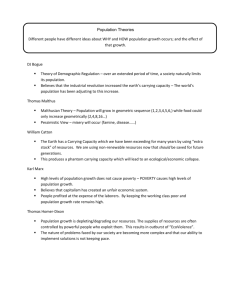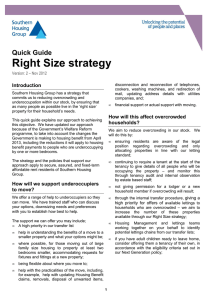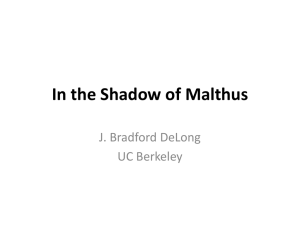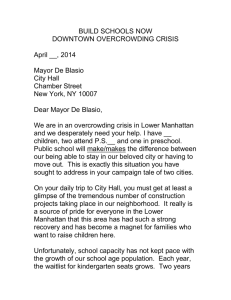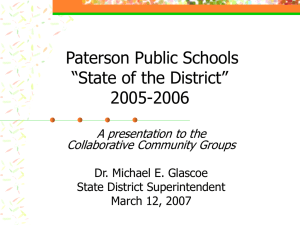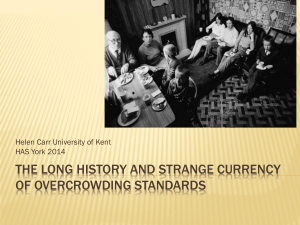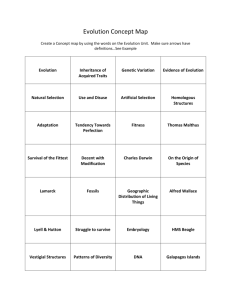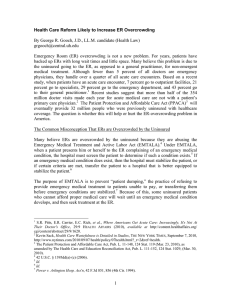Population & the Environment Intro
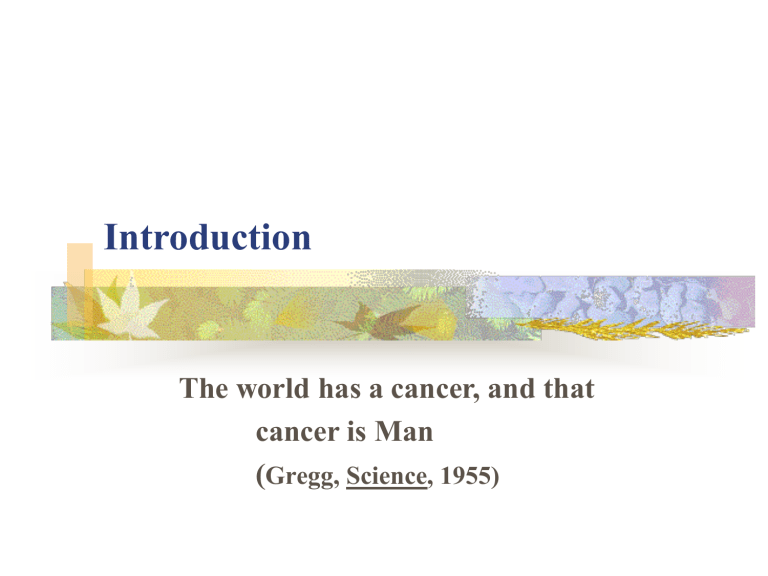
Introduction
The world has a cancer, and that cancer is Man
( Gregg, Science, 1955)
Text begins be asking a fundamental question, whether,
“… at the turn of the twentieth century to the twentyfirst century, the world is becoming over-crowded.”
(p. 1)
--- fears of overcrowding were the impetus for family planning efforts
… success of failure of such programs is perceptual
--- even the term overcrowding has no meaning without context
-
Is the world overcrowded or is the population growing too fast?
“J-Curve” population growth
… to 1840 for 1 billion persons
… to 1927 for 2 billion persons
… to 1960 for 3 billion persons
… to 1974 for 4 billion persons
… to 1987 for 5 billion persons
… to 1998 for 6 billion persons
… to 2020 for 8 billion persons
-
Is the world overcrowded or is the population growing too fast?, cont
This translates to:
… + 7.2 million/mo (another NYC)
… + 87.6 million/yr (another Mexico)
… + 262.8 million/3 yrs (another U.S.)
… + 1.1 billion/13 yrs (another China)
… the context of:
(1) carrying capacity – the maximum population of a given species that a given habitat can support over a given period of time
… for humans affected by level of
technology and societal complexity
Interesting
(a)
(b)
With international trade, international aid and global interaction, the classic definition of carrying capacity has decreasing legitimacy for a local or regional population
A paradox is that initially an increase in economic or social development will increase carrying capacity, but unless constant innovation occurs, development will quickly decrease carrying capacity as the population consumes / pollutes more
(2)
When this overcrowding inconveniences us / over-utilizes our resources / over-taxes our facilities / threatens something valuable to us (socially, economically, environmentally) / etc--
- only then will it have meaning to a population… and thus, different interest groups may hold vastly different views on overcrowding
Malthus
The most influential literature on population overcrowding
An Essay on the Principle of Population as it Affects the Future Improvement of Society (1798)
… argued that population will increase rapidly so long as food was available
… argued that if left uncontrolled, populations would double themselves every 25 yrs ( geometrically)
… argued that even under best conditions, food cannot increase more rapidly than arithmetically
Malthus, cont
… concluded that “checks” to population growth exist:
(a) ultimate check
(b) immediate check
--- preventive
--- positive
Note: preventive checks lower birth rates positive increase death rates
Malthus, cont
The global famine and mass death that Malthus predicted never occurred – he could not take several factors into account:
(1) Industry – productivity grew faster than population
(2) Economics – effect of resource shortage on price and resource exploration
(3) Science – productivity of science / technology to find / create necessary substitutes
From Malthus’ writing and historical experience we derive two forms of overpopulation:
(1) Malthusian
--- malthusian trap
(2) Neo-Malthusian
POPULATION SIZE x
RESOURCE USE/PERSON x
POLLUTION GENERATED/UNIT OF
RESOURCE
Makes the Demographic Transition Model threatening
Still generates intellectual controversy:
Optimists (Simon) vs Pessimists (Ehrlich)
Text is asking if overcrowding is so vague, how do you focus – how do you even know?
Borrowing from discussion of globalization, the text offers several points to explain why populations would begin to feel overcrowded
(1)
The notion that space is shrinking – greater efficiencies in transportation/communication/ etc. – brings about greater immediacy and intimacy of contact with others
… ?Is this really true?
(2) Processes of unequal interdependence may involve us in more threatening contacts – international competition / international corporate decision making / etc
(3) Mixing of people from different ethnic or social backgrounds in particular areas as a result of international migration may increase our contacts with people whose cultural ways we do not share or even understand and whose interests seem to be in competition with ours
Since the 1970s, and works such as Population, Resources,
Environment: Issues in Human Ecology (Ehrlich and
Ehrlich); Limits to Growth and Beyond the Limits to
Growth (Meadows, et al) the environmental movement has put forth more-or-less critical views of development and globalization
--- many of these perspectives continue to be repeated
(ZPG; NPG; O
3
; energy; etc)
… often skeptically viewed as feared catastrophes do not materialize
Social / Economic World vs Natural World
The recurrent theme is a variant of the lifeboat Earth
… and ultimately is a paradox of population, resources and standard of living
Because overcrowding is a function of affluence, material possessions, resource consumption it can be argued
[as your text will] that overcrowding and its effects are an outgrowth of human values and population divisions

